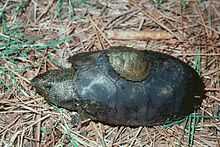Flattened musk turtle
| Flattened musk turtle | |
|---|---|
 | |
| adult and hatchling | |
| Conservation status | |
| Scientific classification | |
| Kingdom: | Animalia |
| Phylum: | Chordata |
| Subphylum: | Vertebrata |
| Class: | Reptilia |
| Order: | Testudines |
| Family: | Kinosternidae |
| Subfamily: | Kinosterninae |
| Genus: | Sternotherus |
| Species: | S. depressus |
| Binomial name | |
| Sternotherus depressus Tinkle & Webb, 1955 | |
| Synonyms[2] | |
| |
The flattened musk turtle (Sternotherus depressus) is a species of turtle in the Kinosternidae family. It is endemic to the southern United States.
Geographic range
S. depressus is an Alabama endemic with a restricted range, historically inhabiting the Black Warrior River drainage of north central Alabama.[3] Serious declines have been observed throughout its range, and it has likely been extirpated from greater than 70% of its historic range, especially in much of the Mulberry and Locust Forks of the upper Black Warrior River Basin. Sipsey Fork populations have fared significantly better due to protection offered by the Bankhead National Forest.
Description
These little turtles can be 7.5–10 cm (3–4 inches) in carapace length, record 11.4 cm (4½ inches). Both the common name and specific name refer to the fact that the species' carapace (upper shell) is much lower and flatter than those of the other members of the genus Sternotherus. In fact they look as if someone had accidentally stepped on them.[3]
Captivity
Individuals of this species have survived for more than 20 years in captivity. Although reproductive rates are low for the species, S. depressus has been bred infrequently in captivity with relative success. Future propagation efforts may be key to preserving and reintroducing the species once its habitat has been restored.
Threats and Causes of Decline
Erosion and siltation from extensive strip mining for coal and damming have been the leading causes of decline in the flattened musk turtle with clear cutting, development, and pollution also playing significant roles in habitat degradation throughout its historic range. As historically rock and bedrock bottom creeks have turned to mud and sand bottom creeks due to erosion, S. depressus has lost the rock crevices it relies on to escape predation and the high stream flow rates that characterize the streams they inhabit.
Sources
- ↑ van Dijk, P.P. (2010). "Sternotherus depressus". IUCN Red List of Threatened Species. Version 2011.1. International Union for Conservation of Nature. Retrieved 8 October 2011.
- ↑ Fritz, Uwe; Peter Havaš (2007). "Checklist of Chelonians of the World". Vertebrate Zoology 57 (2): 262. ISSN 18640-5755. Archived from the original on 2010-12-17. Retrieved 29 May 2012.
- ↑ 3.0 3.1 Conant, Roger. 1975. A Field Guide to Reptiles and Amphibians of Eastern and Central North America, Second Edition. Houghton Mifflin. Boston. 429 pp. ISBN 0-395-19977-8. (Sternotherus depressus, pp. 42–43 + Plate 4 + Map 9.)
Further reading
- Tinkle, D.W., and R.G. Webb. 1955. A New Species of Sternotherus with a Discussion of the Sternotherus carinatus Complex. Tulane Studies in Zoology 3 (3): 53–67.
External links
- Tortoise & Freshwater Turtle Specialist Group 1996. Sternotherus depressus. 2006 IUCN Red List of Threatened Species. Downloaded on 29 July 2007.
| ||||||||||||||||||||||||||||||
| ||||||||||||||||||||||||||||||||||||||||||||||||||||||||||||||||||||||||||||||||||||||||||||||||||||||||||||||||||||||||||||||||||||||||||||||||||||
